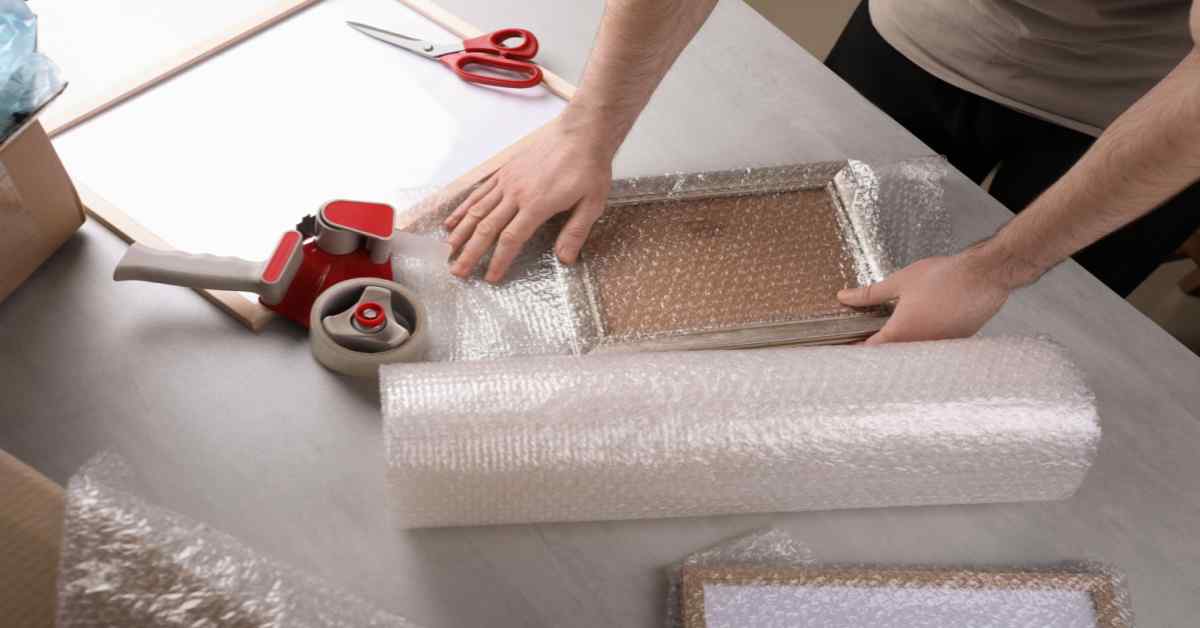Table of Contents
Quality Service Guarantee Or Painting Free

Get a rental agreement with doorstep delivery

Find the BEST deals and get unbelievable DISCOUNTS directly from builders!

5-Star rated painters, premium paints and services at the BEST PRICES!
Loved what you read? Share it with others!


Submit the Form to Unlock the Best Deals Today
Check Your Eligibility Instantly

Experience The NoBrokerHood Difference!
Set up a demo for the entire community

Tenant Super Relax Plan
Enjoy Hassle-Free Renting
 Full RM + FRM support
Full RM + FRM support Instant alerts & premium filters
Instant alerts & premium filters Rent negotiation & relocation help
Rent negotiation & relocation helpThe Best Way to Wrap a Picture Frame: Cost-Effective Pro Tips
Table of Contents
Moving to a new home is an exciting journey, but it can also be a bit stressful, especially when you have cherished artwork to transport. You want to ensure that your artwork arrives at your new destination safely and in the same condition as it left. In this guide, we'll explore the best way to wrap a picture frame and creative photo frame packaging ideas. Whether you're an art collector, a homeowner with valuable paintings, or a photographer with precious prints, we've got you covered. Discover the expert tips and solutions NoBroker offers to make your move worry-free.
Understanding the Value of Proper Packing
Proper packing is indeed crucial when it comes to safeguarding artwork during a move. Whether you're a professional artist, a collector, or simply moving your art collection from one place to another, here are some key reasons why proper packing is essential:
- Protection from Physical Damage: Artwork can be fragile and susceptible to various forms of physical damage during a move. Proper packing, which includes using appropriate padding, cushioning, and sturdy containers, helps protect artwork from impacts, jolts, and rough handling. This is especially important for delicate or valuable pieces.
- Protection from Moisture: Moisture can be a major threat to artwork. Exposure to moisture can lead to mould, warping, and discolouration of paper-based art, while it can cause canvas paintings to stretch or warp. Proper packing materials and techniques create a barrier against moisture, reducing the risk of damage.
- Protection from Environmental Factors: Artwork is sensitive to changes in temperature and humidity. Fluctuations in these environmental factors can lead to warping, cracking, and deterioration of art. Proper packing can include insulation and moisture-resistant materials to mitigate the impact of these factors.
- Preventing Dust and Debris: Dust and debris can accumulate on artwork during a move, and if not properly protected, they can be difficult to clean off, potentially causing damage. Using protective covers and wraps can prevent dust and debris from settling on the artwork.
- Secure Transportation: Proper packing not only safeguards the artwork itself but also ensures it remains securely in place during transportation. This minimizes the risk of the artwork shifting or moving within its packaging, which can cause damage.
- Ease of Unpacking and Display: Proper packing isn't just about protection; it's also about convenience. Using well-organized and labelled packing materials makes it easier to unpack and set up your artwork in your new location, saving you time and reducing the risk of mishandling during unpacking.
- Peace of Mind: Knowing that your artwork is properly packed provides peace of mind. This allows you to focus on other aspects of the move without worrying about the condition of your precious art pieces.
Preparing Your Artwork
Preparing your artwork is a critical preliminary step before packing it for a move. Proper preparation ensures the artwork's integrity and minimizes the risk of damage during the relocation. Here are important steps to follow when preparing your artwork:
Quality Service Guarantee Or Painting Free

Get a rental agreement with doorstep delivery

Find the BEST deals and get unbelievable DISCOUNTS directly from builders!

5-Star rated painters, premium paints and services at the BEST PRICES!
- Cleaning: Before packing, carefully clean your artwork. Dust, dirt, and other contaminants can accumulate on the surface, which, if left uncleaned, can become trapped under packing materials and potentially cause damage over time. Use appropriate cleaning techniques for the specific medium:
- For framed works under glass: Use a soft, lint-free cloth to gently wipe the glass and the frame. Avoid using cleaning solutions that could damage the art or its frame.
- For unframed works: Be cautious with cleaning, as some mediums like pastels or charcoal can smudge. You may want to consult with a conservator for advice on cleaning specific types of art.
- Documentation: Before packing, document your artwork. This documentation is crucial for tracking and verifying the condition of your pieces. Create a detailed inventory that includes photographs, descriptions, dimensions, and any existing damage or imperfections. This serves as a reference point to ensure the artwork remains intact during the move. Consider creating a digital copy of this inventory for added security.
- Assessing Condition: Carefully inspect your artwork for any pre-existing damage or vulnerabilities. This step helps you identify if any repairs or additional protection are needed before packing. If you discover any damage, consider consulting a professional conservator to address the issues properly.
- Disassembling and Removing Hardware: If your artwork has removable components, such as frames or mounts, consider disassembling them to prevent damage during transportation. Store these components separately and securely label them for reassembly at your new location. Remove any hanging hardware, and pack it with the artwork.
- Protective Measures: Use appropriate protective measures based on the type of artwork:
- For framed artwork: Cover the glass or acrylic surface with a protective layer, such as glassine paper or plastic sheeting, to prevent scratches or damage during transport.
- For unframed artwork: Use acid-free tissue paper or glassine paper to protect the surface. For larger pieces or canvases, consider using protective corner protectors.
- Padding and Support: Ensure that your artwork is adequately padded and supported within its packaging. Use cushioning materials like bubble wrap or foam to protect the artwork from shocks and vibrations during transportation. Make sure the artwork is snug within its packaging but not overly compressed, as excessive pressure can cause damage.
- Labeling: Clearly label each artwork package with the artist's name, title of the piece, and any handling instructions. This helps movers or handlers understand the value and fragility of the contents.
- Climate Control: If your artwork is sensitive to temperature and humidity, consider climate-controlled transportation or storage options. Extreme conditions can harm artwork, so take precautions if your pieces are particularly susceptible.
Choosing the Right Packing Materials
Choosing the right packing materials is essential to protect your artwork during a move. Quality packing materials can provide the necessary cushioning, support, and protection to ensure your artwork remains intact. Here are some common packing materials to consider and tips for selecting them:
- Artwork Packaging Boxes: When packing framed or unframed artwork, it's essential to use appropriate-sized boxes. You can find photo frame packaging boxes specifically designed for artwork. These boxes are typically thicker and provide extra protection. Ensure that the box is large enough to comfortably accommodate the artwork with some padding, but not so large that it allows the artwork to shift inside. You can often find such boxes at art supply stores or speciality packing stores.
- Packing Tape: Invest in high-quality packing tape to secure the packaging. Heavy-duty packing tape with strong adhesive is recommended. Make sure the tape is wide enough to provide a secure seal.
- Bubble Wrap: Bubble wrap is an excellent cushioning material for protecting artwork. Wrap the artwork in several layers of bubble wrap, particularly focusing on corners and fragile areas. You can also use anti-static bubble wrap to prevent static electricity from damaging delicate surfaces.
- Foam Inserts: Foam inserts are useful for creating a snug fit inside the packaging box. You can use foam sheets or custom-cut foam inserts to provide additional protection and prevent the artwork from shifting during transportation.
- Glassine Paper: Glassine paper is a non-abrasive, acid-free paper that is ideal for protecting the surface of artwork, especially pieces with glass or acrylic glazing. It prevents sticking and potential damage to the artwork's surface.
- Acid-Free Tissue Paper: Use acid-free tissue paper to protect delicate or sensitive surfaces, such as prints, drawings, and watercolours. It helps prevent acid migration and deterioration of the artwork.
- Cardboard Corner Protectors: These are especially useful for protecting the corners of framed artwork. They prevent chipping and damage to the frame's edges.
- Plastic Sheeting or Stretch Wrap: You can use plastic sheeting or stretch wrap to create a moisture-resistant barrier around the artwork. This is particularly important for protecting against humidity and moisture during transit.
- Labels and Markers: Clearly label each package with information about the artwork, including the artist's name, title of the piece, and any handling instructions. You can also use labels to indicate the top of the artwork to ensure it's handled correctly.
- Custom Crates: For exceptionally valuable or fragile artwork, custom crates may be the best option. These are specially designed containers that provide the highest level of protection. Professional art handlers can assist in creating custom crates.
The Art of Packing
Packing artwork properly is an art in itself, and it's essential to take special care when handling different types of artwork. Here are step-by-step instructions on how to pack various types of artwork, including paintings, sculptures, and framed prints:
Packing Paintings
- Gather Materials: You'll need a photo frame packaging box or a custom-sized box, bubble wrap, acid-free tissue paper, glassine paper, foam inserts, and packing tape.
- Clean and Document: Clean the painting carefully as mentioned in the previous sections. Document its condition and take photographs.
- Wrap in Glassine Paper: Cover the painting with glassine paper to protect the surface. Ensure the glassine is larger than the artwork.
- Layer with Bubble Wrap: Wrap the glassine-covered painting in several layers of bubble wrap. Pay extra attention to corners and edges, as these are vulnerable areas.
- Secure in Foam Inserts: Create custom foam inserts to fit the artwork snugly within the packaging box. These inserts should provide a cushioned and secure fit.
- Place in Box: Carefully place the wrapped and protected painting inside the photo frame packaging box. Add additional cushioning materials to fill any gaps.
- Label and Seal: Label the box with the artwork's details and handling instructions. Seal the box with packing tape securely.
Packing Sculptures
- Gather Materials: You'll need a suitable crate or box, bubble wrap, foam padding, packing tape, and custom packaging materials (such as foam or sculpting clay for support).
- Clean and Document: Clean the sculpture as needed and document its condition.
- Wrap and Protect: Wrap the sculpture in multiple layers of bubble wrap, ensuring that delicate parts are well-padded. For sculptures with protruding or fragile elements, use sculpting clay to create custom support.
- Place in Box or Crate: Place the sculpture inside a crate or a sturdy box, ensuring it is securely positioned. Use foam padding or additional bubble wrap to prevent movement.
- Secure and Label: Seal the crate or box securely with packing tape and label it with the sculpture's details and handling instructions.
Packing Framed Prints
- Gather Materials: You'll need a photo frame packaging box or custom-sized box, acid-free tissue paper, cardboard corner protectors, bubble wrap, and packing tape.
- Clean and Document: Clean the framed print and document its condition.
- Wrap in Acid-Free Tissue Paper: Cover the framed print with acid-free tissue paper to protect the glass, frame, and the print itself.
- Add Corner Protectors: Apply cardboard corner protectors to shield the frame's corners from damage.
- Wrap in Bubble Wrap: Wrap the entire framed print in bubble wrap to provide cushioning.
- Place in Box: Carefully place the wrapped framed print in the packaging box. Ensure it's a snug fit but not overly tight.
- Label and Seal: Label the box with details and handling instructions. Seal the box securely with packing tape.
Innovative Frame Packing Ideas
- If you have multiple framed prints, consider using a custom-made cardboard divider inside the packaging box to separate and protect each piece.
- For valuable or larger framed artwork, you may want to consider a wooden crate or a reinforced packaging box for added protection.
Labelling and Documenting
Labeling and documenting your artwork is essential for a smooth move:
Labeling
- Label each artwork with the artist, title, handling instructions, and orientation.
- Consider a color-coding system for organization.
Creating an Inventory
- Use a spreadsheet with details and photos.
- Note handling instructions and value.
- Make a digital backup and have a hard copy on hand.
Best Way To Wrap A Picture Frame: NoBroker Packers And Movers
In conclusion, ensuring the safe and secure transport of your valuable artwork during a move requires meticulous planning and attention to detail. The best way to wrap a picture frame and the use of creative photo frame packaging ideas play a pivotal role in safeguarding your cherished pieces. Whether you're an art collector, homeowner, or photographer, protecting your artwork is paramount.
Proper packing and photo frame packing ideas are not just about logistics; they are a testament to the care you have for your art. NoBroker understands the value of your art and offers comprehensive guidance and services to make your relocation experience as stress-free as possible.
Your art is more than just decor; it's a reflection of your taste and passion. NoBroker is committed to ensuring that your cherished artwork arrives at your new destination in pristine condition, so you can continue to enjoy and share the beauty it brings to your life.
NoBroker Packers and Movers Tips Testimonials
I have truck for packers and movers what is the procedure to attach vehicle in no broker pls give the directions
I have choosen the n broker packers and movers service. It was effortless and hygiene
NoBroker made my intercity move from Mumbai to Bharuch was completely hassle-free. Their team was prompt, well-organized, and handled my belongings with great care and the movement manager assigned to me Ankit helped me alot throughout the movement with proper updates and follow ups on time. I really appreciate the service.
I recently used NoBroker Packers and Movers for my relocation, and the experience was fantastic. The team was punctual, professional, and handled all my belongings with care. They used high-quality packing materials, ensured safe transportation, and delivered everything on time without any damage. Their customer support was responsive, and the entire process was hassle-free. I highly recommend NoBroker Packers and Movers for a smooth and reliable moving experience!
Trusted company Hassle free services Trained and professional services provided
Amazing care and attention given to all my belongings. Thanks for the great service!
They exceeded all my expectations. I’m so impressed!
I appreciate their punctuality and commitment to timelines
They packed my delicate glassware with extra care. Very professional.
the very wonderful and very experience , genuine person, Genuine nd hard working thank you so much❤
They are so coprotive and nice service I don't get any broke thing
This is a very famous business m i am so very happy
NICE SERVICE
Good packaging
Best packaging ever seen
BOHOT KHUSH
Great packaging
Very good people and handles the items carefully. Recommended!
Very good service on time Delivery
Professional and timely service
.Please approach them guys they are really really good honesty.
I am fully satisfied with the shifting services its all very responsible person keep it up .....
Great service and very prompt service. Extremely professional.
Excellent service provided by the team. Highly professional and experienced
Good service along with good staff. They have taken care of my materials properly. Highly recommend
Great service, excellent work very polite staff handled the product very cautiously...
Very reliable service and very good behaviour.
Good packers and movers service with door pickup to drop !
Nice packaging and professional work
Nice packing , all staff are very cooperative, Timely delivered the items without damaging.
No broker packers and movers are best team for house shifting recently I have shifted they are very polite and professional with lowest price guarantee ,🙌
##Nobroker Packers and Movers It was an amazing experience with you, The team was really supportive & professional, the way they packed and shifted my household stuff it was really good to see. I will recommend nobroker packers and Movers over other packers and Movers.
Great services by No brokers, so efficient and easy ❤️
Satisfying service
A big thank to No broker packer and movers team for providing me such a hassle free shifting within such a less time Professional team with perfection work
No Broker made my move easy and stress-free. Highly recommend them!
I had a smooth move with No Broker. They were on time and professional.
Great service! The team was very helpful and careful with my things
Awesome job by the team! They worked quickly and took care of my belongings."
Most Viewed Articles

15 Best Local Packers and Movers in Bangalore: Quick Home and Office Relocation Services 2025
February 25, 2025
549265+ views

Auspicious Days for Griha Pravesh Muhurat 2025 : Month-Wise Date & Time
May 8, 2025
337275+ views

Bike Transport by Train in India: Charges, Booking Process & Documents Needed in 2025
April 30, 2025
96949+ views

Vehicle Shifting Services in Bangalore: Booking Process, Charges and Required Documents in 2025
February 19, 2025
44801+ views

New House Checklist Before Moving into Your New Home
January 31, 2025
41467+ views
Frequently Asked Questions
A1: Cleaning artwork should be done carefully. Use a soft, lint-free cloth or a brush for dusting. For more thorough cleaning, consult with a professional conservator to ensure the appropriate cleaning method for your specific artwork.
A2: Glassine paper is a non-abrasive, translucent paper that is used to protect the surface of artwork, especially those with glass or acrylic. Acid-free tissue paper is used to protect delicate surfaces and prevent acid migration and deterioration.
A3: The choice of packing materials depends on the type and size of your artwork. Common materials include photo frame packaging boxes, bubble wrap, foam inserts, and more. Consult with professionals or art supply stores for advice on selecting the right materials for your specific pieces.
A4: Creating an inventory is highly recommended. It helps track your artwork, document its condition and simplify the unpacking process. It's especially crucial if you have a valuable or extensive art collection.
A5: It's generally better to label the packaging rather than the artwork itself to avoid potential damage. Use high-quality, legible labels or write directly on the packaging materials.
A6: Custom crates are a great option for extremely valuable or fragile artwork. They provide the highest level of protection. Consult with professional art handlers to determine if custom crates are necessary for your pieces.
A7: Use moisture-resistant packaging materials like plastic sheeting or stretch wrap. Ensure your artwork is enclosed in a waterproof layer to safeguard against humidity and moisture.
A8: Yes, it's essential to inform the moving company about your valuable artwork. They should be aware of the fragility and value of the items they are handling. Consider purchasing additional insurance for added protection.
A9: The choice depends on the size, value, and fragility of your artwork. While smaller and less valuable pieces can be moved with care, it's often safer to hire professional art handlers for valuable or delicate artwork to ensure it arrives safely.
A10: Unpack your artwork carefully following the labelling and inventory. Position it in its new location, ensuring proper hanging and lighting. If you have valuable or delicate pieces, consider consulting professionals for the setup.
Loved what you read? Share it with others!
Recent blogs in
NoBroker Packers and Movers: Application, Booking Charges and Reviews in 2025
May 30, 2025 by NoBroker.com
12 Best Packers and Movers in Mumbai: Budget-Friendly Relocation Services in 2025
May 27, 2025 by Siri Hegde K




Join the conversation!